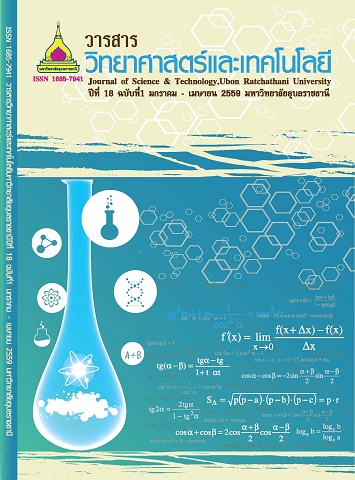การแยกแลคติกแอสิดแบคทีเรียจากอาหารหมักเพื่อนำมาพัฒนาเป็นตัวนำดีเอ็นเอ
Main Article Content
บทคัดย่อ
การศึกษานี้มีวัตถุประสงค์เพื่อหาแลคติกแอสิดแบคทีเรียที่เหมาะสมไปพัฒนาเป็นตัวนำดีเอ็นเอเข้าสู่ร่างกายมนุษย์ จากการแยกแลคติกแอสิดแบคทีเรีย (LAB) จากปลาส้มและผักดอง ได้ LAB จำนวน 42 ไอโซเลต ซึ่งมีเพียง 10 ไอโซเลตเท่านั้น (SF-02, SF-03, SF-09, SF-10, SF-12, SF-15, SF-17, SF-18, SF-20 และ SF-22) ที่สามารถยับยั้งได้ทั้ง Escherichia coli และ Listeria monocytogenes เมื่อนำ LAB ทั้ง 10 ไอโซเลตดังกล่าว ไปศึกษาการทนกรด และเกลือน้ำดี พบว่า เฉพาะ LAB รหัส SF-09 เท่านั้นที่ทนกรดที่ pH เท่ากับ 2 และทนเกลือน้ำดีที่ความเข้มข้นเท่ากับ 0.30% ได้ การตรวจสอบสายพันธุ์ของ LAB รหัส SF-09 โดยวิธี 16S rDNA sequence analysis พบว่าลำดับเบสของ 16S rDNA ของ LAB ดังกล่าวคล้ายกับลำดับเบสของ 16S rDNA ของ Enterococcus faecium strain LMG 11423 ด้วยเปอร์เซ็นต์ความคล้ายเท่ากับ 99% ดังนั้นจึงเรียก LAB ดังกล่าวว่า E. faecium SF-09 การทดลองสกัดพลาสมิดจาก E. faecium SF-09 ทาให้ทราบว่าแบคทีเรียดังกล่าวไม่มี พลาสมิด เมื่อทดลองนำ vector DNA pFLP1 เข้าสู่เซลล์ของ E. faecium SF-09 โดยวิธี electroporation พบว่าแบคทีเรียดังกล่าวสามารถรับเอา pFLP1 เข้าสู่เซลล์ได้ และพลาสมิดดังกล่าวยังสามารถคงอยู่ภายในเซลล์ของ E. faecium SF-09 ได้ การศึกษานี้แสดงให้เห็นว่า E. faecium SF-09 มีศักยภาพที่จะนำไปปรับปรุงสายพันธุ์ให้เป็นตัวนำ DNA เข้าสู่ร่างกายของมนุษย์ต่อไป
Isolation of Lactic Acid Bacteria from Fermented Foods to be developed as DNA Delivery Vehicles
This study aimed to find a suitable lactic acid bacterium for further development as a vehicle to deliver DNA into the human body. A total of 42 lactic acid bacteria (LAB) isolates were obtained from Pla Som (fermented fish) and fermented vegetables, 22 from the former and 20 from the latter. Of the isolated LAB, only 10 isolates (SF-02, SF-03, SF-09, SF-10, SF-12, SF-15, SF-17, SF-18, SF-20 และ SF-22) had antimicrobial ability against both Escherichia coli and Listeria monocytogenes. When these 10 LAB isolates with antimicrobial activity were tested for their tolerance to acid and bile salt, it was found that only LAB SF-09 was tolerant to acid at pH 2 and to bile salt at the concentration of 0.3%. The identification of LAB SF-09 by 16S rDNA sequence analysis revealed that its 16S rDNA sequence showed 99% homology to that of Enterococcus faecium strain LMG 11423. Therefore, LAB SF-09 was designated E. faecium SF-09. Plasmid isolation showed that E. faecium SF-09 contained no plasmid. The introduction of vector DNA pFLP1 into E. faecium SF-09 cells was successful by electroporation and the vector was found to be stable in the cells. This study showed that E. faecium SF-09 had potential for further genetic modification as a vehicle to deliver DNA into the human body.
Article Details
บทความที่ได้รับการตีพิมพ์เป็นลิขสิทธิ์ของ วารสารวิทยาศาสตร์และเทคโนโลยี มหาวิทยาลัยอุบลราชธานี
ข้อความที่ปรากฏในบทความแต่ละเรื่องในวารสารวิชาการเล่มนี้เป็นความคิดเห็นส่วนตัวของผู้เขียนแต่ละท่านไม่เกี่ยวข้องกับมหาวิทยาลัยอุบลราชธานี และคณาจารย์ท่านอื่นๆในมหาวิทยาลัยฯ แต่อย่างใด ความรับผิดชอบองค์ประกอบทั้งหมดของบทความแต่ละเรื่องเป็นของผู้เขียนแต่ละท่าน หากมีความผิดพลาดใดๆ ผู้เขียนแต่ละท่านจะรับผิดชอบบทความของตนเองแต่ผู้เดียว


